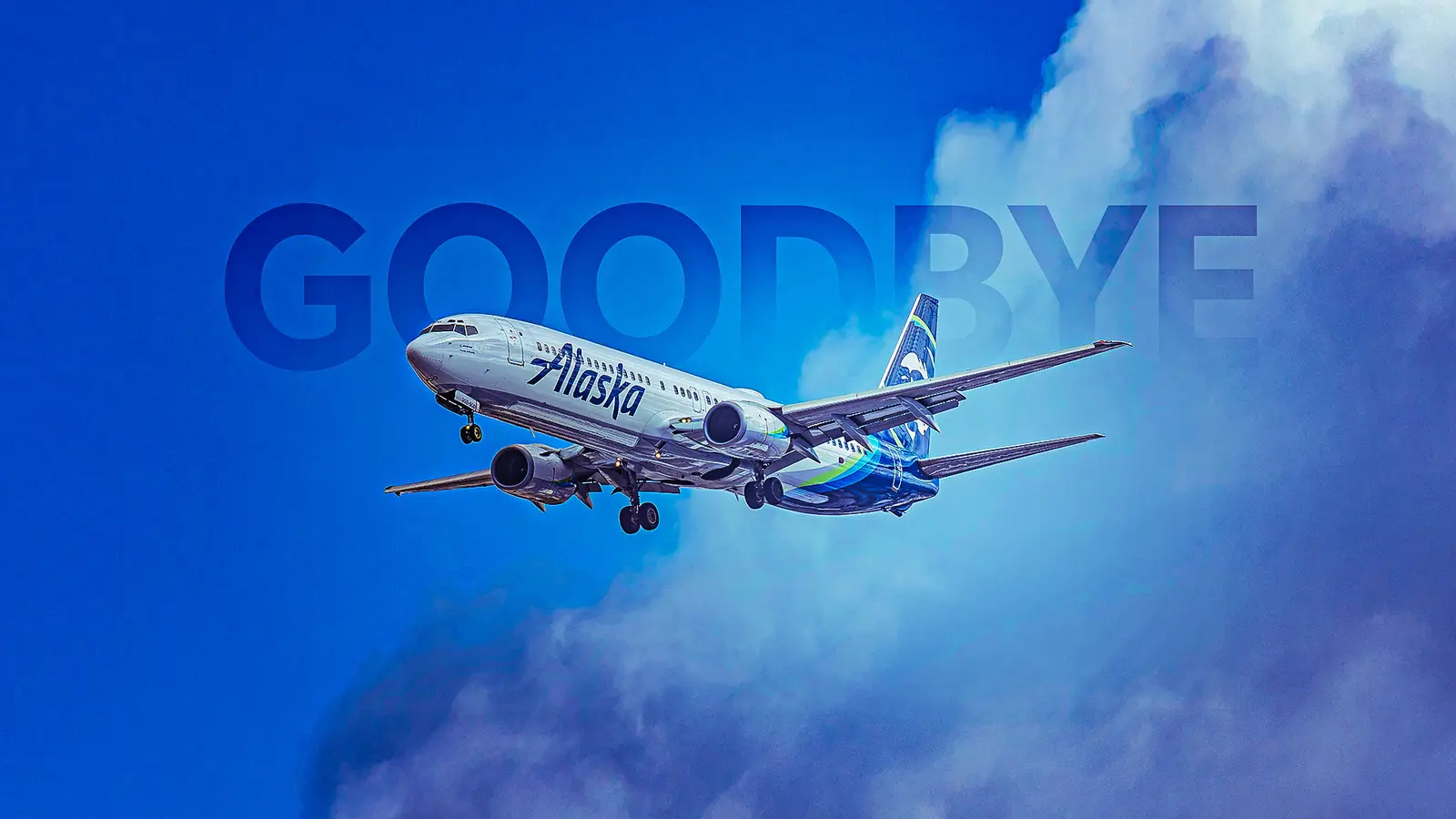
Alaska Airlines has retired the last of its dozen 737-900 aircraft. The carrier was the launch customer for the type, and the 737-900s, delivered between 2001 and 2003, were the oldest and most outdated aircraft in its fleet. With over 20 years of service, these planes were approaching their second heavy maintenance check.
The first was retired in April 2025, and the last of the 12 jets was just ferried to storage a week ago, according to Airline Geeks. As a type that never performed to expectations, the poor economics of the aircraft has only grown worse in comparison to new planes.
Envisioned as a high-density hauler in the Alaska Airlines’ fleet, the 737-900s were hoped to boost capacity and range. Due to the layout, the maximum passenger capacity was the same as the -800 and would only be remedied in the 737-900ER. Selling the underwhelming -900s is now one component of the airline’s modernization efforts. Alaska Airlines can simultaneously cut expenses and improve profits by retiring these aircraft.
Out With The Old: 737 Next Generation
The performance and dependability of the airline’s 737-900 Next Generations (737NG) are directly related to its choice to sell them. It is a calculated action to maximize its fleet flexibility, efficiency, and boost overall productivity. The older 737-900s are no longer needed by Alaska Airlines, which has a sizable fleet of 737-900ERs and is currently receiving 737 MAX aircraft. The airline can invest in its newer, more capable fleet by selling these planes.
The -900s may be appealing to other airlines or lessors because they have been well-maintained and have a long remaining serviceable life. The well-known shortcomings, however, may well see the planes become spare parts sources instead of scrap. The liquidation is par for the course in the growing airline’s continuous endeavor to enhance its competitiveness.
Alaska Airlines’ fleet strategy is focused on introducing modern, efficient jets that meet the needs of its passengers and keep operating expenses as low as possible. The outdated cabins, low seat numbers, and relatively poor fuel efficiency of the winglet-less -900s all contributed to their demise. New planes like Boeing 737 MAX simply beat the now-retired planes in every class, making their replacement inevitable practically from day one.
In With The New: 737 MAX
The majority of the -900 series were delivered between 2001 and 2008; therefore, even if they did provide quality service, those airframes will be facing expensive maintenance milestones and environmental retrofits by now. Instead, Alaska is shifting to the Boeing 737 MAX family as the new backbone of its narrowbody fleet. Primarily the 737-9, but eventually the larger 737-10 will be brought online instead of investing in expensive checks on underperforming old jets.
The MAX 9 seats 178 passengers in Alaska’s two-class configuration in a near one-for-one replacement of the 737-900ER. It burns roughly 20% less fuel thanks to the CFM LEAP-1B engines, redesigned winglets, lighter composites, and a refreshed systems architecture. Over a typical domestic transcontinental flight, the MAX 9 saves hundreds of gallons of jet fuel, trimming literal tons of CO₂ emissions. Those savings cascade into lower Carbon Offsetting and Reduction Scheme for International Aviation (CORSIA) liabilities and help Alaska inch toward its publicly stated goal of net-zero emissions by 2040.
Alaska has 88 of the new Boeing 737-8 and 737-9 with plans for even more, especially the stretched 737-10, as Planespotter.net records. Boeing’s Sky Interior on the MAX jets features sculpted sidewalls, adaptive LED lighting, and redesigned overhead bins. Every seat will have a USB-C port and power outlet, and gate-to-gate streaming speeds will be made possible by satellite communication. First-class pitch is also increased to 41 inches without lowering main-cabin capacity. Recaro chairs have 31-inch pitch in economy, and in flight entertainment (IFE) can be streamed to personal devices.
Operational Hang Ups
Compared to the Boeing 737-900ER and 737 MAX, the 737-900s have lower limits in terms of income while also requiring extra resources to sustain. As a unique sub-fleet of Alaska Airlines’ aircraft, the 737-900s demanded separate procedures, spare parts inventory, and crew training. Eliminating this small sub-fleet will save expenses in a number of areas, including crew and pilot training.
Although Alaska Airlines configures the 737-9 for 178 seats, they are certified for a maximum of 220 passengers, as shown on aeroLOPA. That is the same seat capacity as the -900 but with a better cabin space and leaner burning engines to pad the bottom line and improve the flying experience. The 737-8 seats just 17 fewer passengers. The combined qualities of the all-737 fleet give Alaska more options than ever before in terms of network planning.
Ben Minicucci, CEO, commented on the fleet modernization efforts in August 2025 that include flying 737-8 jets to international destinations, saying:
“With these bold moves, we are accelerating our vision to connect our guests to the world. We are seizing this moment to redefine the international experience and level up. And we’re doing it with the same relentless focus on safety, care and performance that’s always defined us. I’m so proud of how our people continue to step up and deliver as we push ahead on these initiatives, with even more to come.”
Alaska Airlines has firm orders and options for up to 120 new 737 MAX aircraft since 2022. The sale of the 737-900s will make room on the airline’s flightline and release pilots, mechanics, and gates for the incoming MAX aircraft. That will simplify the operations and improve profitability.
Financial Considerations
Alaska Airlines will be more capable of investing in its modern planes with the cash infusion from the sale of the -900s. With the money, the airline can put funds back into its expansion goals and enhance its overall financial performance. Other airlines or lessors find the 737-900s appealing despite the lackluster performance since they still have residual value and cost far less than a new plane.
The announcement of the 737 MAX order in 2022 was the largest of its kind in the airline’s history. Alaska Airlines CEO, Ben Minicucci, remarked:
“This investment secures aircraft to optimize our growth through the next decade, which we know will be a formidable competitive advantage. We’re proud of the strong financial foundation that uniquely positions Alaska to make this commitment to our future, and of the fantastic partnership we share with our hometown aircraft manufacturer at Boeing.”
The post-pandemic aviation market has seen a roller coaster of production highs and lows from Boeing. That has had lessors, parts dealers, and startup carriers bidding for serviceable 737NG airframes. By selling its 737-900s, Alaska converts a depreciating asset into cash that can be better used for other purposes.
New But Familiar
The MAX family retains the 737’s easily accommodated fuselage and wheelbase that doesn’t require any airport changes. Even airfields that board and deplane on the tarmac can make the change with minimal modifications to ground-service equipment (GSE). To cut down on the amount of time that the auxiliary power unit (APU) runs, Alaska is even investing in recharging carts that can power the aircraft’s systems during extended ground holds and reduce emissions.
Environmental critics argue that leveraging next-generation turbofan efficiency is merely an incremental step when the industry needs transformative carbon solutions. Alaska is an early investor in ZeroAvia’s hydrogen fuel-cell Dash 8 project and is studying electric short-haul platforms for its Horizon Air subsidiary. Retiring older, thirstier jets today frees up capital and immediately reduces fleet average emission while supporting emerging technologies without compromising stability.
For flyers, the transition will feel evolutionary rather than disruptive. The quieter cabin, faster climb rate, new cabin, and smoother ride quality are all comfort upgrades. In the next two or three years, Alaska expects more than 70% of its mainline aircraft to be MAX family. That will slash the average fleet age to under seven years and create a marketing point that resonates with both travelers and investors.
The Risky Side
The MAX program’s well-publicized grounding and recertification saga forced Alaska to hedge its future aircraft procurement by extending some 737-900 leases longer than originally planned. After the dust settled and the global fleet was back in the sky, Alaska’s in-service MAX 9 fleet has logged a dispatch reliability of 99%.
The carrier did suffer a door blow out in 2024 due to an improperly installed door plug on one 737 MAX. That incident led to further review at Boeing and prompted a merger with Spirit Aerosystems, which made the fuselage. The Federal Aviation Administration (FAA) has continued to monitor the 737 MAX assembly line since the fatal crashes of Lion Air and Ethiopian Airlines jets in 2019. The door blow-out only cemented the need for continued scrutiny.
Boeing is now entering the final stages of its merger with Spirit Aerosystems and looking to potentially increase its production cap as the 737-7 and 737-10 are also nearly certified. Boeing is aiming to ramp up output next year as many customers around the world are waiting impatiently for the new planes, including Alaska, Southwest, and United Airlines among others.



